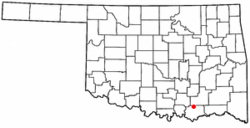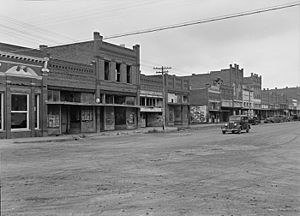Caddo, Oklahoma facts for kids
Quick facts for kids
Caddo, Oklahoma
|
|
|---|---|
| Motto(s):
"...The antique town on a buffalo trail"
|
|

Location of Caddo, Oklahoma
|
|
| Country | United States |
| State | Oklahoma |
| County | Bryan |
| Area | |
| • Total | 1.69 sq mi (4.38 km2) |
| • Land | 1.69 sq mi (4.38 km2) |
| • Water | 0.00 sq mi (0.00 km2) |
| Elevation | 722 ft (220 m) |
| Population
(2020)
|
|
| • Total | 1,017 |
| • Density | 601.06/sq mi (232.02/km2) |
| Time zone | UTC-6 (Central (CST)) |
| • Summer (DST) | UTC-5 (CDT) |
| ZIP code |
74729
|
| Area code(s) | 580 |
| FIPS code | 40-10800 |
| GNIS feature ID | 2413147 |
Caddo is a town in Bryan County, Oklahoma, United States. In 2020, about 1,017 people lived there. The town's name comes from a Caddo Native American word, ka do hada’ cho, which means "real chief." It was also named after the nearby Caddo Hills.
Contents
History of Caddo
Early Days and Native American History
The first people to live in the Caddo area were the Caddo and Choctaw Native American tribes. A local story says that the Caddos and Choctaws had a big battle in 1840. This battle happened about two miles southeast of where Caddo is today. The Choctaws won the fight, and the Caddos moved away.
How Caddo Started
In 1872, the land where Caddo now stands was officially claimed. This area was on an old buffalo trail. The very first settlers lived in tents.
Later in 1872, the Missouri-Kansas-Texas Railroad (often called Katy) built a train line through the Choctaw Nation. They set up a station in Caddo. A post office opened on December 18, 1872. By Christmas Day, the railroad reached Denison, Texas.
Caddo's Growth and Importance
By 1873, Caddo had about 400 people. It quickly became an important place for shipping goods and trading in the area. By 1890, Caddo was growing fast. It had five cotton gins, which are machines that separate cotton fibers from their seeds. The population grew to 2,170 people. Caddo officially became a city in 1898. At that time, it was the biggest town in the region.
When Caddo was first founded, it was part of Blue County. This was a section of the Pushmataha District within the Choctaw Nation.
The Jefferson Highway
In 1915, Caddo was on the route of the Jefferson Highway. This was a very long road, stretching over 2,300 miles. It connected Winnipeg, Canada, all the way to New Orleans, Louisiana.
Why Caddo's Population Changed
The St. Louis and San Francisco Railway (called Frisco) planned to build a new train line. When people heard this, land prices in the area went up. However, Frisco decided to build their line through Durant instead of Caddo. Because of this, Durant started to grow much faster than Caddo. Durant later became the main town, or county seat, when Bryan County was formed. By 1930, Caddo's population had gone down to 933 people.
A newspaper editor from Caddo, Guy A. Crossett, wrote about the town's changes in 1943. He explained that other towns like Durant and Hugo had grown bigger. He felt Caddo had relied too much on its past glories.
Geography of Caddo
Caddo covers an area of about 2.1 square miles (5.4 square kilometers). All of this area is land.
Population Information
| Historical population | |||
|---|---|---|---|
| Census | Pop. | %± | |
| 1900 | 930 | — | |
| 1910 | 1,143 | 22.9% | |
| 1920 | 1,421 | 24.3% | |
| 1930 | 933 | −34.3% | |
| 1940 | 954 | 2.3% | |
| 1950 | 895 | −6.2% | |
| 1960 | 814 | −9.1% | |
| 1970 | 886 | 8.8% | |
| 1980 | 923 | 4.2% | |
| 1990 | 918 | −0.5% | |
| 2000 | 944 | 2.8% | |
| 2010 | 997 | 5.6% | |
| 2020 | 1,017 | 2.0% | |
| U.S. Decennial Census | |||
In 2000, there were 944 people living in Caddo. These people lived in 387 households, and 255 of these were families. The town had about 449 people per square mile.
Most people in Caddo were White (about 78%). About 14% were Native American. A small number were African American or Asian. About 7% were from two or more races. About 1.6% of the population was Hispanic or Latino.
About 29% of households had children under 18. More than half (51.9%) were married couples living together. About 32% of all households were single people living alone. About 16% of households had someone aged 65 or older living alone.
The average age of people in Caddo was 40 years old. About 24% of the population was under 18. About 23% was 65 years or older.
Fun Things to Do
Caddo has a special event called the Heritage Day Festival. This festival happens every year on the first Saturday in October.
Famous People from Caddo
- Gail Farrell: A singer, songwriter, and pianist who grew up in Caddo.
- Lydia Starr McPherson: She started an early newspaper in Caddo called the Caddo International News.
- Gary Richardson: Born in Caddo, he was a United States attorney.
- Cowboy Pink Williams: He was the 7th lieutenant governor of Oklahoma.
See also
 In Spanish: Caddo (Oklahoma) para niños
In Spanish: Caddo (Oklahoma) para niños


